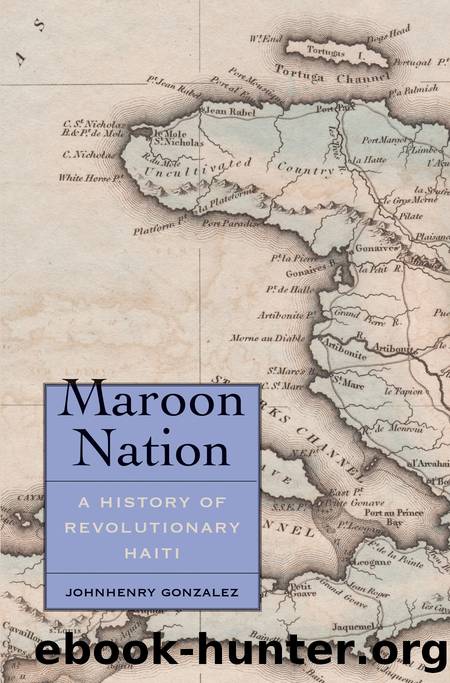Maroon Nation by Johnhenry Gonzalez;

Author:Johnhenry Gonzalez;
Language: eng
Format: epub
ISBN: 9780300245554
Publisher: Yale University Press
CHAPTER FIVE
The Land Question and the Triumph of the
Haitian Republic
THE Haitian Revolution and the process of decentralized settlement described in this book represented not the first but the second major wave of maroon settlement on Hispaniola. In The Repeating Island, a dense tome filled with postmodern wordplay, the Cuban thinker Antonio BenÃtez-Rojo explores the comparative dimensions of Caribbean history and the cyclically parallel historical processes that unite the histories of a varied and divided archipelago.1 Spanish Santo Domingo was the initial nexus of African slave importation in the Americas and the site of the first Caribbean sugar boom during the first half of the sixteenth century. Plantation slavery quickly spawned violent rebellion, and in 1522 Wolof slaves launched an uprising on the plantation of Columbusâs son Diego Colón. By the 1540s, maroon communities had become entrenched in the islandâs interior. Slaves who ran away or who were manumitted became roving cattle hunters and farmed small plots, or conucos. This early, maroon-like social substrate of black and mixed-race independent producers was the origin of much of the population of Spanish Santo Domingo.
Richard Turits points out that as late as the early twentieth century, the Dominican rural interior was so rustic and sparsely settled that so-called monterÃa remained one of the main modes of economic subsistence.2 This was the name for the capture and slaughter of feral and semi-feral swine, goats, and cattle. Centuries of rough, rural freedom in el monte was the historical outgrowth of early colonial patterns of marronage and metropolitan neglect.
As with the early Haitian grain trade that augmented the food supply of the Jamaican slave plantations, maroon economies could exist in a kind of ironic symbiosis with neighboring slave colonies. The unregulated, decentralized, pastoral economy of colonial Santo Domingo grew during the eighteenth century because of a cross-island trade that supplied essential draft animals to the booming slave plantations of French Saint-Domingue.
Following the Haitian Revolution, Hispaniola became an island characterized by two different maroon economic modes: intensive Haitian food farms in the west and sprawling, unfenced Dominican cattle operations in the east. These two maroon modes came to intermingle and overlap each other along the unregulated, ill-defined border of the nineteenth and early twentieth centuries. As Haitiâs population grew and as its government took control of the east, former Spanish colonial towns became Haitian towns. Hinche and Saint Michel de LâAttalaye are probably the two largest examples. But the names of a variety of Haitian towns, such as Lascahobas, Cerca Carvajal, Los Cacaos, or Los Palis, attest to their early history as Spanish colonial settlements. Spanish-speaking people who could perhaps best be described as âethnic Dominicansâ made up part of the population of these regions. Also, in an extension of the maroon pattern of state evasion, Haitian farmers fled conscription and the dangers of the periodic insurrections of the late nineteenth and early twentieth centuries by settling across the border where land was more abundant. Haitians set up farms in a variety of Dominican border communities, but they were especially numerous around Restauración, Loma de Cabrera, and Dajabón in the north.
Download
This site does not store any files on its server. We only index and link to content provided by other sites. Please contact the content providers to delete copyright contents if any and email us, we'll remove relevant links or contents immediately.
| Antigua | Bahamas |
| Barbados | Cuba |
| Dominica | Dominican Republic |
| Grenada | Haiti |
| Jamaica | Saint Kitts |
| Saint Lucia | Saint Vincent |
| Trinidad and Tobago |
Cat's cradle by Kurt Vonnegut(14760)
Pimp by Iceberg Slim(13779)
Underground: A Human History of the Worlds Beneath Our Feet by Will Hunt(11838)
4 3 2 1: A Novel by Paul Auster(11791)
The Radium Girls by Kate Moore(11621)
Wiseguy by Nicholas Pileggi(5317)
American History Stories, Volume III (Yesterday's Classics) by Pratt Mara L(5134)
Perfect Rhythm by Jae(5071)
The Fire Next Time by James Baldwin(5016)
Paper Towns by Green John(4798)
Pale Blue Dot by Carl Sagan(4616)
A Higher Loyalty: Truth, Lies, and Leadership by James Comey(4550)
The Mayflower and the Pilgrims' New World by Nathaniel Philbrick(4280)
The Doomsday Machine by Daniel Ellsberg(4245)
Killers of the Flower Moon: The Osage Murders and the Birth of the FBI by David Grann(4188)
The Sympathizer by Viet Thanh Nguyen(4093)
Too Much and Not the Mood by Durga Chew-Bose(4091)
The Borden Murders by Sarah Miller(4016)
Sticky Fingers by Joe Hagan(3912)
